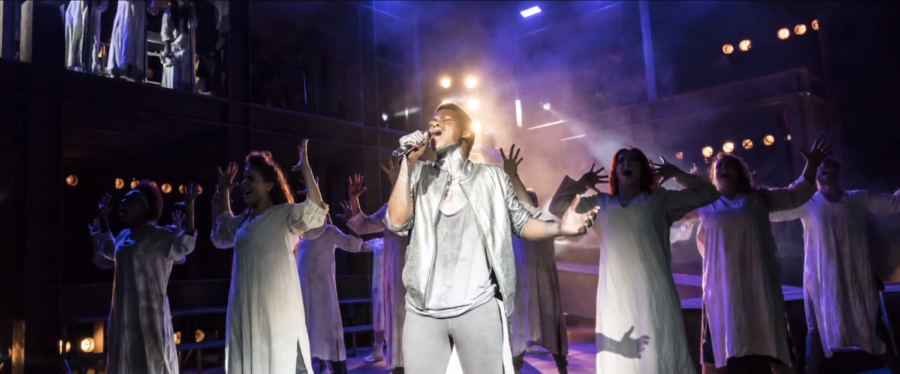Like its playwright, who penned the production when he was 23 years old, Jesus Christ Superstar needs no introduction. A revival of Andrew Lloyd Weber and Tim Rice’s beloved opera, the biblical production is now playing at the Lyric Opera House. Directed by three-time Olivier award winner Timothy Sheader, the Chicago show effortlessly continues the renewed wave of explosive energy, following the special live production earlier this year starring John Legend and Sara Bareilles that was broadcast to about 9.4 million viewers.
The musical is a retelling of Judas’s betrayal of Jesus, but it is far from the Sunday school story. Jesus (Heath Saunders) carries an electric guitar, Mary Magdalene (Jo Lampert) rocks a shaved head and raccoon eye shadow, and disciples descend into hysteria like front-row fans at Lollapalooza. There is only room for rock screams and electric guitar riffs. With a robust orchestra in addition to a rock band, the Lyric Opera’s production features over 80 artists on stage—twice the size of the original London production.
That original show debuted in 1970, when the play’s choice to portray Jesus Christ as a rock star—especially one with doubts about his own legitimacy—and to give Judas an empathetic treatment bristled even some of the most devoted rock and opera fans. This production is a welcome, modernizing update. There is strong representation of black and brown folks onstage, an especially refreshing change from the consistently white casts of previous productions. Gone too are restrictive notions of gender; women eat at the Last Supper, and Lampert’s shaved head gives Mary an unprecedented androgynous spin.
The musical’s barn-burning vocal numbers, however, haven’t changed a bit. Despite a huge cast, soloists are still able to seize the stage. Lampert’s vocals are especially striking; in “I Don’t Know How to Love Him,” Mary, alone on stage, wonders about her description-defying love for Jesus. Lampert’s heart-aching croon is touching, but delivered with resolve. Ryan Shaw is just as enchanting in “Judas’s Death”; he conveys powerful grief and disbelief at Jesus’s cruel, faithless treatment. The vulnerability that flickers through Shaw’s performance, along with his representation of Judas’s anguish, pays lip service to the humanity in history’s most notorious bad guy.
The show wasn’t without its technical foibles; one-liners that function as comedic relief risk getting lost in actors’ polyphonic screams, in addition to the limits of the venue’s amps. The imperfections of the audio system, however, are also a touching reminder that one is, after all, in the Lyric Opera House, which was not intended to host the likes of Prince and KISS.
The show is undeniably a feast for the eyes. The fast pace of killer vocals and fulminant choreography—the stage, at some points, morphing into a hungry vortex of swirling gray clothing belonging to Jesus’s followers—is enough to hold audience’s amazement. But their radiance is matched by costumes that range from low-key hoodies to a 28-foot-long golden cape, the end of which recedes to the back of the stage, unseen. It comes as no surprise that costume designer Tom Scutt once collaborated with Sam Smith at the Tate Modern; the designs are instantly recognizable as the “effortless cool” of celebrities caught on their way to attend the next London fashion show. Show notes detailed how the costumes drew inspiration from Chicago’s neighborhoods: Pontius Pilate’s (Michael Cunio) leather jacket and combat boots make him look as though he just stepped off his motorcycle in Wicker Park. This may be the first time audiences see Jesus dressed in street-smart sweatpants and a long cardigan, an ensemble that resembles that of Kanye West—which was also no accident.
The effect of the costumes and choreography is reminiscent of glam-rock maximalism; “excessive” may as well be emblazoned on the handbook of Jesus Christ Superstar. Ninety pounds of gold confetti, raining down in whorls, are tossed into the air in handfuls and cling to the clothes of performers. Watching the first round of glitter fall onto the stage may trigger some worry for the neat audience member, if only for the painstaking task of cleaning it up. The continuous flurry of gold is of such magnitude that I suspect intermission is 25-minutes long only so the crew has time to sweep away the confetti.
The confetti also acts as an unshakeable reminder of the power of performance. When Judas asks Jesus whether he is truly the son of God, Jesus replies, “That’s what you say.” For a nanosecond, one can see the flash of remnant glitter clinging to his clothes, forgotten and unnoticed by its wearer. Jesus Christ Superstar is much the same. Its astoundingly delivered tracks and dazzling set design are sure to accompany audience members home long after the curtain has gone down.









